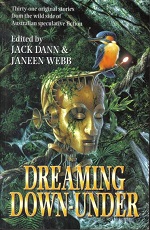The Truth about Weena
- by David J. Lake
- Short Story
- Science Fiction
- Adults
- Definite Time Travel
- English
- “The Truth about Weena” by David J. Lake, in Dreaming Down-Under, edited by Jack Dann and Janeen Webb (Voyager, September 1998).
David Lake is a noted scholar on Wells and author of Darwin and Doom: H.G. Wells and the Time Machine wherein he notes that Wells knew of the paradoxes involved in time travel, but didn’t want to address them in what he saw as a serious story about social trends. So, Lake says, his own Weena story is a shot at showing “what really happens in backward time travel,” which in this case is a model where backward time travel causes the universe to split. Lake handles the idea consistently, although for me, Lake’s afterward to the story fails to fully acknowledge the history of the split-universe idea, and the afterward does not give sufficient credit to single timeline alternatives.
On the other hand, I love stories that tell us what truly happened in another well-known story, and Lake handles that well, telling us in the voice of the original narrator about what truly happened to the Traveller (for so it will be convenient to speak of him) after he first returned to 1891 and subsequently set out to rescue Weena.
On the other hand, I love stories that tell us what truly happened in another well-known story, and Lake handles that well, telling us in the voice of the original narrator about what truly happened to the Traveller (for so it will be convenient to speak of him) after he first returned to 1891 and subsequently set out to rescue Weena.
Well, in its hitherto published form it was partly fiction, because at the time—1895—I could not write the full truth. The full truth was even more fantastic than the fiction—too fantastic, surely, to be believed; or if believed, too disturbing to received notions of Time. And besides, there were living people to protect: in particular, one young person who was very dear to us.

Variants
(1)
- “The Truth about Weena” by David J. Lake, in Dreaming Down-Under, edited by Jack Dann and Janeen Webb (Voyager, September 1998).
